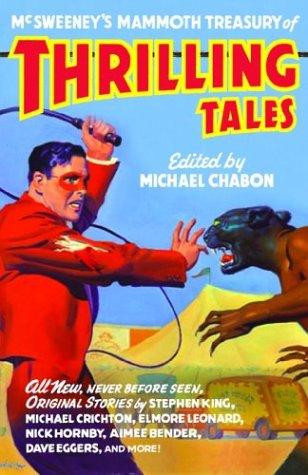
by Kelly Link
from McSweeney’s Mammoth Treasury of Thrilling Tales
In the introduction to this collection of short stories Michael Chabon, whose Pulitzer Prize-winning novel The Amazing Adventures of Kavelier & Clay I thoroughly enjoyed, posits that the “short fiction” of yester-year has been replaced with “the contemporary, quotidian, plotless, moment-of-truth revelatory story.” For the most part, I’d have to say that I agree with him. I love “The New Yorker” but I tend to skip their short fiction selections. Of course, I feel like a fat failure when I do but when I read a short story I tend to appreciate it more if it has a plot. This is why I enjoy reading anthologies of classic short stories that include selections like Shirley Jackson’s “The Lottery”, Kate Chopin’s “Story of an Hour”, or Guy de Maupassant’s “The Necklace.” It’s also the reason why I decided to try out Thrilling Tales.
As strange as it is, “Catskin” does satisfy the plot requirement…kind of. In a nutshell, – I think I can do this in less that three sentences – “Catskin” tells the story of a witch and her devoted son. For much of the story, the witch, who is actually dead and has consequently turned into a talking cat, and her son, who is dressed in a cat’s skin (don’t ask), journey to the house of Lack, the witch responsible for killing the ‘cat’ witch, seeking revenge. That would have been all well and good if the story hadn’t been so damn creepy and just plain odd. Take this selection for instance, a story the witch tells Small, her ten year-old son:
“A long time ago, when men and women were going to build a house, they would
dig a hole first. And they’d make a little room – a little, wooden, one-room house – in the hole. And they’d steal, or buy, a boy or a girl to put in the house in the hole, to live there. And then they built their house over that first little house…The boy or the girl stayed in that little house…They lived there all their life, and they are living in those houses still, under the other houses where the people live, and the people who live in the houses above may come and go as they please, and they don’t ever think about how there are little houses with children sitting in the little rooms, under their feet.”
The creepiest part of the tale above for me was not only its content but also that, in the world of “Catskin” it’s quite possible that it’s true. There's a scene in the story in which they actually open up one of the houses in a hole. Nothing comes out but I think Link wants readers to believe that it could. The creepiness of “Catskin” lies in that it plays upon the complete vulnerability of children. Children are kidnapped, abandoned, tossed into rivers, burned alive, and turned into captive kittens. I’m sure if I liked the story more, I could come up with something like “it’s-commenting-on-the-fragile-bonds-that-exist-between-parents-and-their-children” critical analysis – I was after all, an English major – but I don’t. I don’t like stories in which children seem to die just for the hell of it.
And the cats were just so damn creepy, ands I like cats! But after reading this story, I think I’ll be avoiding them for a while. Plus, I understand that in the world of “Catskin” we’re dealing with witches and magic so everything isn’t going to be explicable, but what was up with those gold bars miaowing, and how is a ten-year old boy dressed in a cat suit small enough to look like an actual cat? And what was up the red ants that spurted out of dead bodies carrying “pieces of time’ in their mouths? Okay, I get the metaphor but still, disturbing. And what happened to the ending in the story? It’s as if the writer got bored with her story and just ended it and purposely left the story and its readers with no resolution. How else do explain the last paragraph:
“The Princess Margaret grows up to kill witches and cats…There
is no such thing as witches, and there is no such thing as cats, either, only
people dressed up in catskin suits.”
Allll-right. And what was up with those damn cats?
Friday, December 22, 2006
Catskin
Labels:
Books
Subscribe to:
Comments (Atom)
